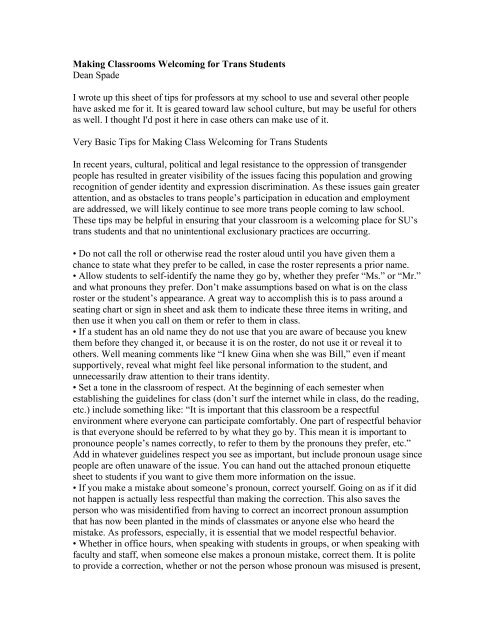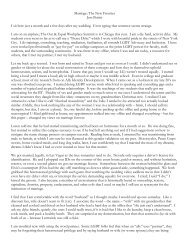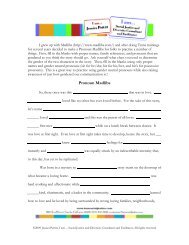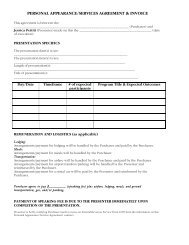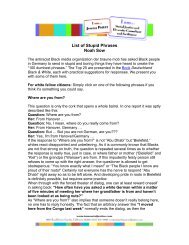Making Classrooms Welcoming for Trans ... - I am... Safe Zone
Making Classrooms Welcoming for Trans ... - I am... Safe Zone
Making Classrooms Welcoming for Trans ... - I am... Safe Zone
Create successful ePaper yourself
Turn your PDF publications into a flip-book with our unique Google optimized e-Paper software.
<strong>Making</strong> <strong>Classrooms</strong> <strong>Welcoming</strong> <strong>for</strong> <strong>Trans</strong> Students<br />
Dean Spade<br />
I wrote up this sheet of tips <strong>for</strong> professors at my school to use and several other people<br />
have asked me <strong>for</strong> it. It is geared toward law school culture, but may be useful <strong>for</strong> others<br />
as well. I thought I'd post it here in case others can make use of it.<br />
Very Basic Tips <strong>for</strong> <strong>Making</strong> Class <strong>Welcoming</strong> <strong>for</strong> <strong>Trans</strong> Students<br />
In recent years, cultural, political and legal resistance to the oppression of transgender<br />
people has resulted in greater visibility of the issues facing this population and growing<br />
recognition of gender identity and expression discrimination. As these issues gain greater<br />
attention, and as obstacles to trans people’s participation in education and employment<br />
are addressed, we will likely continue to see more trans people coming to law school.<br />
These tips may be helpful in ensuring that your classroom is a welcoming place <strong>for</strong> SU’s<br />
trans students and that no unintentional exclusionary practices are occurring.<br />
• Do not call the roll or otherwise read the roster aloud until you have given them a<br />
chance to state what they prefer to be called, in case the roster represents a prior n<strong>am</strong>e.<br />
• Allow students to self-identify the n<strong>am</strong>e they go by, whether they prefer “Ms.” or “Mr.”<br />
and what pronouns they prefer. Don’t make assumptions based on what is on the class<br />
roster or the student’s appearance. A great way to accomplish this is to pass around a<br />
seating chart or sign in sheet and ask them to indicate these three items in writing, and<br />
then use it when you call on them or refer to them in class.<br />
• If a student has an old n<strong>am</strong>e they do not use that you are aware of because you knew<br />
them be<strong>for</strong>e they changed it, or because it is on the roster, do not use it or reveal it to<br />
others. Well meaning comments like “I knew Gina when she was Bill,” even if meant<br />
supportively, reveal what might feel like personal in<strong>for</strong>mation to the student, and<br />
unnecessarily draw attention to their trans identity.<br />
• Set a tone in the classroom of respect. At the beginning of each semester when<br />
establishing the guidelines <strong>for</strong> class (don’t surf the internet while in class, do the reading,<br />
etc.) include something like: “It is important that this classroom be a respectful<br />
environment where everyone can participate com<strong>for</strong>tably. One part of respectful behavior<br />
is that everyone should be referred to by what they go by. This mean it is important to<br />
pronounce people’s n<strong>am</strong>es correctly, to refer to them by the pronouns they prefer, etc.”<br />
Add in whatever guidelines respect you see as important, but include pronoun usage since<br />
people are often unaware of the issue. You can hand out the attached pronoun etiquette<br />
sheet to students if you want to give them more in<strong>for</strong>mation on the issue.<br />
• If you make a mistake about someone’s pronoun, correct yourself. Going on as if it did<br />
not happen is actually less respectful than making the correction. This also saves the<br />
person who was misidentified from having to correct an incorrect pronoun assumption<br />
that has now been planted in the minds of classmates or anyone else who heard the<br />
mistake. As professors, especially, it is essential that we model respectful behavior.<br />
• Whether in office hours, when speaking with students in groups, or when speaking with<br />
faculty and staff, when someone else makes a pronoun mistake, correct them. It is polite<br />
to provide a correction, whether or not the person whose pronoun was misused is present,
in order to avoid future mistakes and in order to correct the mistaken assumption that<br />
might now have been planted in the minds of any other participants in the conversation<br />
who heard the mistake. Allowing the mistake to go uncorrected ensures future<br />
uncom<strong>for</strong>table interactions <strong>for</strong> the person who is being misidentified.<br />
• Never ask personal questions of trans people that you would not ask of others. Because<br />
of the sensationalist media coverage of trans people’s lives, there is often an assumption<br />
that personal questions are appropriate. Never ask about a trans person’s body or medical<br />
care, their old n<strong>am</strong>e, why or how they know they are trans, their sexual orientation or<br />
practices, their f<strong>am</strong>ily’s reaction to their gender identity or any other questions that are<br />
irrelevant to your relationship with them unless they invite you to do so or voluntarily<br />
share the in<strong>for</strong>mation.<br />
• If you meet a student outside the classroom in a setting where they did not already get<br />
to self-identify via your seating chart, and you are not sure of the proper pronoun <strong>for</strong><br />
them, ask. One way to do this is by sharing your own. “I use masculine pronouns. I want<br />
to make sure to address you correctly, how do you like to be addressed?” This may seem<br />
like a strange thing to do but a person who often experiences being addressed incorrectly<br />
may see it as a sign of respect that you are interested in getting it right rather than making<br />
assumptions. If you are not sure and do not want to ask, you can also avoid using<br />
pronouns—but making a pronoun assumption is the worst option.<br />
Taking it Further<br />
If you want to take your awareness of these issues further, here are some additional ideas<br />
to consider.<br />
• Educate yourself about trans history, trans law, and trans resistance. There are<br />
wonderful resources on the internet, in addition to many law review articles and books of<br />
all kinds. Some great resources <strong>for</strong> trans law in<strong>for</strong>mation include the <strong>Trans</strong>gender Law<br />
and Policy Institute (www.transgenderlaw.org), The <strong>Trans</strong>gender Law Center<br />
(www.transgenderlawcenter.org), the Sylvia Rivera Law Project (www.srlp.org), and the<br />
TGI Justice Project (www.tgijp.org).<br />
• Include trans issues on your syllabus, and help your students learn how to talk about<br />
these issues respectfully and understand their importance. Important trans legal struggles<br />
can be found in tax, trusts and estates, f<strong>am</strong>ily law, employment, civil rights, criminal law<br />
and criminal procedure, administrative law, poverty law, housing, public benefits, torts,<br />
etc. These cases might be a chance <strong>for</strong> students to f<strong>am</strong>iliarize themselves with the<br />
obstacles facing a community that is severely underserved by the legal profession.<br />
• Think about how gender norms, or ideas about what men and women should be like,<br />
might be being en<strong>for</strong>ced in your classroom or in other parts of your life. What does it<br />
mean to stand up against the rules of gender, both in the law and in other areas of our<br />
lives? How might we be en<strong>for</strong>cing gender norms on our selves or our loved ones with<br />
well-meaning advice or guidance? Exploring these questions can deepen our commitment<br />
to gender self-determination <strong>for</strong> all people and to eliminating coercive systems that<br />
punish gender variance.
Pronoun Etiquette<br />
People often wonder how to be polite when it comes to problems of misidentifying<br />
another person’s pronoun. Here are some general tips:<br />
1) If you make a mistake, correct yourself. Going on as if it did not happen is actually<br />
less respectful than making the correction. This also saves the person who was<br />
misidentified from having to correct an incorrect pronoun assumption that has now been<br />
planted in the minds of any other participants in the conversation who heard the mistake.<br />
2) If someone else makes a mistake, correct them. It is polite to provide a correction,<br />
whether or not the person whose pronoun as misused is present, in order to avoid future<br />
mistakes and in order to correct the mistaken assumption that might now have been<br />
planted in the minds of any other participants in the conversation who heard the mistake.<br />
3) If you aren’t sure of a person’s pronoun, ask. One way to do this is by sharing your<br />
own. “I use masculine pronouns. I want to make sure to address you correctly, how do<br />
you like to be addressed?” This may seem like a strange thing to do but a person who<br />
often experiences being addressed incorrectly may see it as a sign of respect that you are<br />
interested in getting it right.<br />
4) When facilitating a group discussion, ask people to identify their pronouns when they<br />
go around and do introductions. This will allow everyone in the room the chance to selfidentify<br />
and to get each others’ pronouns right the first time. It will also reduce the<br />
burden on anyone whose pronoun is often misidentified and may help them access the<br />
discussion more easily because they do not have to fear an embarrassing mistake.<br />
Comments<br />
I realize this applies way less to law school...but in so many other classes, it might be<br />
relevant: In class activities, don't separate into groups by gender (e.g. - all the women will<br />
be be on debate te<strong>am</strong> A, and all the men on te<strong>am</strong> B).<br />
also, in language classes (especially when it is a more gendered language than English,<br />
such as Spanish, Arabic, etc.), the s<strong>am</strong>e guidelines you outlined regarding pronouns need<br />
to apply to any statements that would indicate a students' gender. For ex<strong>am</strong>ple, being<br />
addressed with the wrong gender of verb or adjective is just as humiliating as being<br />
addressed with the wrong pronoun.<br />
When facilitating a group discussion, ask people to identify their pronouns when they go<br />
around and do introductions. This will allow everyone in the room the chance to selfidentify<br />
and to get each others’ pronouns right the first time. It will also reduce the<br />
burden on anyone whose pronoun is often misidentified and may help them access the<br />
discussion more easily because they do not have to fear an embarrassing mistake.<br />
Can we reaffirm that facilitators in pronoun-go-rounds should be ready to address cis<br />
privilege? I have experienced cases were cis participants throw off flippant answers about<br />
how evident their pronouns are (i.e. "female/feminine/male/masculine, of course" or<br />
similar sorts of comments).
Yes, non-trans people can have really problematic responses to these go-rounds when<br />
they aren't use to them or don't understand the point. Frequently I find people who are not<br />
trans will make a joke of it or will say they don't care which pronoun is used <strong>for</strong> them in a<br />
way that implies "look how cool and flexible I <strong>am</strong>" without understanding the privilege<br />
that can make that a very different statement <strong>for</strong> them than <strong>for</strong> a trans person whose<br />
gender identity is regularly ignored, mistaken or punished (kind of like when non-trans<br />
people in trainings I do report that they have used the "wrong" bathroom on occasion<br />
because a bathroom had a long line and it was fine <strong>for</strong> them, not realizing that a person<br />
who is trans appearing or gender non-con<strong>for</strong>ming appearing gets a very different<br />
response when entering bathrooms than a non-trans appearing person entering a "wrong"<br />
bathroom because of a particular circumstance). Thanks <strong>for</strong> pointing this out!<br />
21 January 2010 @ 01:55 pm<br />
http://cruciferous.livejournal.com/15984.html?view=133232#t133232


